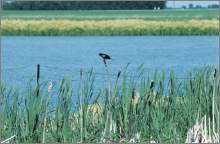Wildlife Services Kills 1.7 Million Animals Yearly
by www.SixWise.com
A little known branch of the U.S. Department of Agriculture (USDA), known discreetly as Wildlife Services, has killed more than 7 million animals since 2003. And they do it with taxpayer money.
|

Farmers may depend on Wildlife Services to protect their livestock from predators.
|
In fact, every year 1.7 million animals fall at the hands of Wildlife Services. Animals like bears, bobcats, coyotes, herons, hawks -- even endangered wolves, cats and dogs. And at costs of over $100 million a year.
Wildlife Services (WS), according to their own Web site, "responds to requests by the public and agencies in need of help in dealing with wildlife damage. WS has the authority to assist in solving problems that are created when wildlife causes damage to agricultural property, or natural resources. WS also assists with wildlife problems involving threats to human health and safety and threatened or endangered species."
The site continues, "WS acts as a protective buffer, guarding not only resources, but also wildlife and the environment when conflicts between humans and wildlife occur. When formulating control strategies, WS specialists consider protected or endangered animals, environmental impacts, the cost effectiveness of control methods, and social and legal concerns. Control strategies may include the application of one or more techniques, and consideration is first given to nonlethal methods."
In theory, WS sounds like a reasonable idea. After all, someone needs to help those who find themselves with a bear in their backyard or a coyote in their kitchen. And WS is the go-to agency should a flock of geese take over an airport. But dogs and cats? Endangered wolves?
This demands answers.
Is Wildlife Services Really Looking Out for Wildlife?
So sketchy is the information on WS' Web site that it's hard to get a feel for what exactly they do. Even an Internet search turns up little info, except for an article published in Men's Journal last year. Take a look at this excerpt from that article:
"On average its [WS'] 1,450 officers shoot, trap, or poison more than 1.7 million animals every year, mostly in western states. In 2006 alone, Wildlife Services dispatched more than 200,000 mammals, including 278 endangered gray wolves, 318 black bears, 2,500 bobcats, and 87,000 coyotes, according to the agency's annual reports."
"The agency's hunters and trappers -- exterminators, in practice -- set out on foot and horseback and in ATVs, jeeps, airplanes, and helicopters; their victims include not just mammals but redwing blackbirds, cormorants, herons, hawks, and even bald eagles, as well as domestic pets whose deaths are often ignored or even, critics claim, covered up by agents in the field. In 2006 Wildlife Services killed 1,184 cats and 512 dogs."
"The carnage is just staggering," says Wendy Keefover-Ring, the director of carnivore protection for Sinapu, a wildlife conservation group. She points out that WS has wiped out more than 7 million critters since 2003. "Wildlife Services is like the wildlife equivalent of Blackwater, shooting first and deflecting questions later.""
Apparently, an amendment was once passed that would have stopped funding for WS, but ranchers successively persuaded lawmakers to reverse the decision. The American Farm Bureau then reportedly sued so that the names of those who benefited from the reversed decision would be kept quiet.
"The trappers take great satisfaction in killing animals. Dispensing poisons and weapons and traps," Brooks Fahey, founder of Predator Defense, told Men's Journal. "The jobs are passed down from father to son. There's a lot of nepotism in Wildlife Services."
|

Wildlife Services killed 128 red-winged blackbirds in Illinois during 2007 ... why is not specified.
|
Biological Warfare Agents? On Wildlife?
Among the many weapons in WS' bag of tricks are two poisons -- sodium cyanide and sodium fluoroacetate, commonly called Compound 1080. Currently, conservation groups have petitioned the government to ban these highly toxic biological warfare agents.
- Sodium Cyanide: Used to make M-44s, which are spring-loaded devices topped with bait lures that spray poison into an animal's mouth when triggered. M-44s commonly kill badgers, bears, birds, coyotes, dogs, skunks, raccoons and more. Endangered species have also been killed by the devices.
The U.S. Environmental Protection Agency (EPA) also has records of at least five WS employees and five other people being exposed to cyanide from M-44s.
-
Compound 1080: Though banned in 1972, the decision was later reversed to allow the substance in livestock protection collars, used to protect sheep and goats from predators. Compound 1080 is highly toxic, yielding a painful death that can take up to 15 hours. The collars are easily punctured, thereby exposing livestock to the chemical, and scavengers that feed on dead livestock are often poisoned.
What Else is There to Know About Wildlife Services?
According to WS figures, of the animals taken by the agency in 2007, 86 percent were "dispersed" (often using firearms), 0.21 percent were freed, and nearly 14 percent were killed. If you'd like to see a breakdown of how many, and what types of, animals were killed in your state last year, you can see WS' figures for yourself.
In 2007 in Illinois, for instance, WS intentionally killed:
And this is only a sampling. In all, WS killed 30,083 animals in Illinois last year.
The agency's ultimate purpose is to act as a liaison between human beings and the wild -- to foster a mutually respectful relationship. Whether or not this mission is still being upheld at the agency remains controversial.
Recommended Reading
13-Foot Pythons Now Challenging 6-Foot Alligators in the Everglades
Five of America's Most Dangerous Wild Animals -- How to Beware!
Sources
Sinapu November 28, 2007
DailyPaul.com
WNBC.com
OjaiOrange.com
USDA: Wildlife Damage